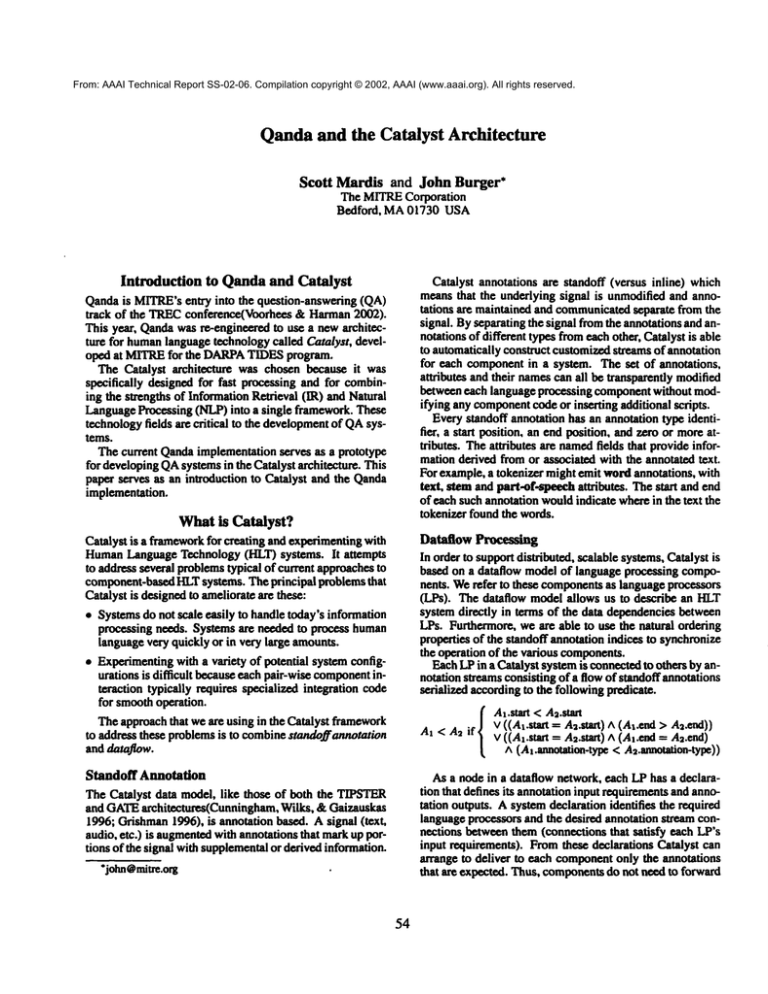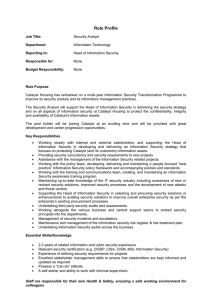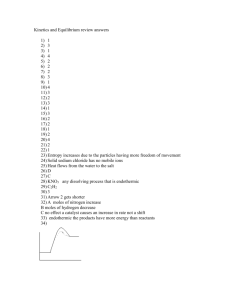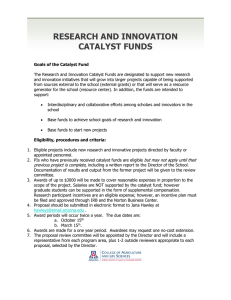
From: AAAI Technical Report SS-02-06. Compilation copyright © 2002, AAAI (www.aaai.org). All rights reserved.
Qandaand the Catalyst Architecture
Scott
Mardis and John Burger*
The MITRECorporation
Bedford, MA01730 USA
Introductionto Qanda
andCatalyst
Qandais MITRE’sentry into the question-answering (QA)
track of the TRECconference(Voorhees & Harman2002).
This year, Qandawas re-engineered to use a newarchitecture for humanlanguage technology called Catalyst, developed at MITREfor the DARPA
TIDESprogram.
The Catalyst architecture was chosen because it was
specifically designed for fast processing and for combining the strengths of InformationRetrieval (IR) and Natural
LanguageProcessing (NIP) into a single framework. These
technologyfields are critical to the developmentof QAsysictus.
The current Qandaimplementation serves as a prototype
for developingQAsystems in the Catalyst architecture. This
paper serves as an introduction to Catalyst and the Qanda
implementation.
What
is Catalyst?
Catalyst is a frameworkfor creating and experimentingwith
HumanLanguage Technology (HLT) systems. It attempts
to address several problemstypical of current approachesto
component-basedlILT systems. The principal problems that
Catalyst is designedto ameliorateare these:
. Systemsdo not scale easily to handle today’s information
processing needs. Systems are needed to process human
languagevery quickly or in very large amounts.
¯ Experimentingwith a variety of potential system configurations is difficult because each pair-wise component
interaction typically requires specialized integration code
for smoothoperation.
The approach that we are using in the Catalyst framework
to address these problemsis to combinestandoff annotation
and dmaflow.
Standoff Annotation
The Catalyst data model, like those of both the TIPSTER
and GATEarchitectures(Cunningham, Wilks, & Gaizauskas
1996; Grishman1996), is annotation based. A signal (text,
audio, etc.) is augmentedwith annotations that markup portions of the signal with supplementalor derived information.
"john@mitre.org
54
Catalyst annotations are standoff (versus inline) which
meansthat the underlying signal is unmodified and annotations are maintained and communica~d
separate from the
signal. By separating the signal fromthe annotations and annotations of different types from each other, Catalyst is able
to automatically construct customizedstreams of annotation
for each componentin a system. The set of annotations,
attributes and their namescan all be transparently modified
between each language processing componentwithout modifying any componentcode or inserting additional scripts.
Every standoff annotation has an annotation type identitier, a start position, an end position, and zero or moreattributes. Theattributes are namedfields that provide informationderived from or associated with the annotated text.
For example, a tokenizer might emit word annotations, with
text, stem and part-of-speech attributes. The start and end
of each such annotation wouldindicate wherein the text the
tokenizer found the words.
Dataflow Proces~ag
In order to supportdistributed, scalable systems,Catalyst is
based on a datafiow model of language processing components. Werefer to these componentsas language processors
(LPs). The datafiow model allows us to describe an HLT
system directly in terms of the data dependencies between
LPs. Furthermore,
we are able to use the natural ordering
properties of the standoff annotation indices to synchronize
the operation of the various components.
EachLP in a Catalyst systemis connectedto others by annotation streams consisting of a flow of standoff annotations
serialized accordingto the followingpredicate.
Al.Stmt < Aa.sLml
V ((At.start = A2.start) A (At.end > Aa.end))
AI< A~if v ((Al.start ---- Aa.start) A(At.end---- Aa.end)
^ (Al.annotation-type< Aa.annotation-type))
As a node in a datafiow network, each LP has a declaration that defines its annotation input requirementsand annotation outputs. A systemdeclaration identifies the required
language processors and the desired annotation stream connections between them (connections that satisfy each LP’s
input requirements). Fromthese declarations Catalyst can
arrange to deliver to each componentonly the annotations
that are expected. Thus, componentsdo not need to forward
annotations unrelated to their specific function. For example, a sentence tagger mayconsumethe bf wordannotations
produced by the tokenizer described above, and emit annotations indicating the boundariesof sentences. The sentence
tagger need not copy the wordsto its output--if a third component requires both sentences and words, Catalyst will arrange to deliver the outputs of the tokenizer and the sentence
tagger, suitably merged.
Catalyst’s dataflow approach to building HLTsystem has
a numberof advantages.
¯ Error dependencies between components are limited to
the precisely specified data dependencies.
¯ By using dedicated peer-to-peer channels Catalyst eliminates the cost of parsing and generating generic annotation interchange formats (such as XML)between independently constructed components.
¯ Componentdevelopers maywork directly with an annotation model, rather that with particular data interchange
formats. (Catalyst will support the exchangeof data in
XML
for system I/O and for use with componentsnot prepared for direct use in a Catalyst system.)
¯ A system can be run on a single machineor distributed
across many.Individual componentscan be replicated to
increase throughput.
s Componentcode can be simplified because the data presented is alwaysconsistent with the LPspecification.
Distributabmty
Catalyst annotation streams are transported over sockets and
can be connected betweenprocesses on manymachines, permiring a wide range of processing strategies for optimizing
system performance without having to rewrite component
code. Onceproperly workingon a single host, distributing a
systemacross manymachinesrequires only starting a server
on each machineand editing a few lines in the system configurationfile.
addedlater as needed. Multiple loggers can be created simultaneouslyto record several views of the log at different
levels of detail and can be used to create logs at multiple
destinations.
The Catalyst monitor is used to examinethe configuration
and state of a Catalyst system. Usingthe monitor, a component or systemdeveloper can obtain snapshots of the current
system configuration and track the flow of data through a
system. The monitor provides information such as the list
of current running components, the connecting annotation
streams, the amountof information buffered with the system, the current indices for the various streams, etc. Debugging multicomponentsystems such as Qandarequires a facility to examinethe global systemstate easily. The monitor
is an important tool for quickly diagnosingcomponentinteraction problemsand identifying performancebottlenecks.
Information Retrieval
in Catalyst
In addition to addressing someof the general problems of
lILT system construction, Catalyst is also an experimentin
developing a frameworkfor combiningNLPand IR in a single system. Standoff token annotations, grouped by term,
form the basis of an inverted index for terms in a large corpus, similar to those used by traditional IR engines. By extending this usageto all other types of annotation, Catalyst
permits the developmentof fast information retrieval techniques that query over NLP-generatedproducts (see exampies below).
Catalyst’s dataflow model, combinedwith flexible inverted index streams, makesit possible to develop systems
that can utilize both pre- and post-index NLPto improve
the speed of query responses. Also, retrieval engines can
be built that directly answercomplexqueries as neededfor
question answering(e.g., retrieve all paragraphscontaining
a person and one of terms A or B).
Implementing Qanda using Catalyst
Our previous TRECefforts have used inline-XMLpipeline
architectures, where all componentsmonotonically added
XMLmarkup to retrieved documents. This approach had
a numberof problems:
Control
A networkof Catalyst servers exchangeinformation for the
purpose of creating and maintainingCatalyst-based systems.
Connectionsarc negotiated by servers and then handed-off
to componentprocesses. A single script, compiled from a
static dataflow description of the system, worksin concert
with the servers to create each system. Servers also route
and deliver control commands
to each language processor.
Logging and Monitoring
A multi-process, distributed systemcan be difficult to debug
and maintain. To assist componentand system developers
in this regard, Catalyst has both distributed logging and distributed monitoringcapabilities.
TheCatalyst log capability allows logger processes to collect informationfrom someor all of the processes in a Catalyst system. Logginginformation includes events such as
whenlanguage processors are stopped or started, user log
messages, commandevents, errors, etc. Logs may be created at the same time the systemis instantiated or maybe
55
¯ Componentsdownstreamhad to understand (or at least
parse) all upstreamannotations, in order to ensure that
these earlier annotations wereproperly replicated on output.
¯ This led to an inflation of the markupon documents:Often the final documents comprised 99%markup and 1%
underlying character data.
¯ Somecomponents’ only purpose was to rewrite markup
to makeit more palatable to downstrearacomponents.
¯ R is difficult to parallelize such an architecture.
Our current Catalyst-based architecture suffers from none
of these problems. Every componentis delivered only the
annotations that it requires to do its job. If a component
is producing annotations that no other componentcurrently
I
Wrapper ] [ [ Tagger/Filter
] ~ Retagger .I
/
Collation
Entity
I
$C
Figure l: Qandaas a Catalyst System--Widearcs indicate file system IO, narrow arcs are lightweight Catalyst annotation
streams.
requires, Catalyst quietly drops themon the fioor? If necessary, we can instruct Catalyst to mapbetween different
annotation types in order to accommodate
differences in the
natural representations of different components.
Catalyst also allows us to lay the system out in a more
natural mannerthan a single pipeline. Figure I showsour
TRECsystem, which is naturally expressed as a directed
graph. Note that many componentsdo not need to communicate with each other, even indirectly, and can thus run in
parallel, e.g., most of the entity taggers. Althoughwe have
not yet taken advantageof it, Catalyst will allow us to run
language processors on different machines,even replicating
slower componentsin order to increase throughput.
UsingCatalyst
Workingwith Catalyst entails developing Catalyst-enabled
componentsand assembling them into a system. Catalyst is
designed to simplify this secondtask. First we describe the
general way in whichCatalyst systems are constructed; next
we showtwo possible paths for integrating existing technology with Catalyst.
tOf course, the preferred behaviorwouldbe for the component
to neglectcomputing
sUCh
annotations
in the first place, but at least
theyare not further processed.
56
Building a System in Catalyst
Figure 2 shows howthe major componentsof Catalyst (the
library, the server and the configurationcompilers)are used
in creating a runningsystem. A configuration file is written
for each language processing componentCL.P). It specifies
whichannotation streams it is able to process and whichit
generates. A componentcompiler transforms the configuration file into headerfiles andother static informationthat are
used to create each Catalyst-enabled executable. A system
configurationfile, referring to LPconfigurationfiles, defines
which LPs are needed in a system and the stream connections that arc required between the LPs. The system compiler transformsthe systemconfiguration file into a startup script that is used to instantiate the system. The script
(presently a PERL5.0 script) communicatesonly with Catalyst servers, whosefunction is to create the operating system processes that will contain the LPs, establish connections between them, and forward configuration and control
information fromthe script to each process.
The Catalyst library (linked into each componentprocess) handles annotation communication between components and passes control informationto and from the servers.
The library can mergeannotations from manydifferent components and produce a single annotation stream specialized
A running system
Machine 1]
Library
[ Machine 2
¯
÷
I
I.~
Config
f’de
Build
Catalyst
Component
~
Component
Executable
!
!
~1;"v~’
]1o114
I,, l
J
Config
file
Compile
System
Startup
Script
o# |
I
I
I
_l
itJ
t..............................
/
¯"
,iplserver
I
L
........
l
Figure 2: HowCatalyst Builds a System---Configurationcompilers transform configuration files into header, data, and script
files that are used to create language processors[LPs] and systems. A compiledstart-up script uses the networkof Catalyst
servers to create a running system. The system, once started, passes annotations via peer-to-pcer communicationmanagedby
the Catalystlibrary.
to each component’sinput declaration. Similarly, a single
stream of output from a component can be broken down
into its constituent annotations and attributes and delivered
piece-meal to manydestinations. In this way, Catalyst delivers to each component,the precise set of annotations required by the component’sdeclaration.
Integrating
with Catalyst
There are two basic ways of integrating existing components
with Catalyst: writing a Catalyst wrapperprocess and using
the Catalyst API. The purpose of a Catalyst wrapperprocess
is to convert the Catalyst annotations streams to and from
a data format that an existing black box componentuses.
The Catalyst API, of course, provides direct access to all of
Catalyst’s features and provides maximum
benefit.
A wrapperprocess allows one to connect existing technology into Catalyst without having to modify the component
code. This is the only choice for componentsfor which the
codeis unavailable. It wouldprovide the advantageof delivering a precise set of annotations to the wrappedcomponent
but it wouldsuffer from the cost of transformation to and
from the appropriate interchange format. Also, U’ansforming
annotations from standoff to inline formats and back again
(as most componenttechnologies wouldrequire) can be difficult. TheCatalyst project is, however,planningdirect support for inline annotations in XML
to facilitate integration
via wrapperprocesses.
The Catalyst API defines a standoff annotation modeland
57
provides methodsfor sharing data via annotation streams.
Standoff annotations allow for overlap in ways that cannot
be constructed in an inline format such as XML,permitting,
for example, componentsto output manypossibly overlapping noun phrase bracketings or answer candidates. Additionally, a componentcan receive an annotation stream that
contains the combinedoutputs of several componentsthat
all share the sametask (e.g., it is simple to developa component that looks at IV different tagger outputs and selects
the best tags by combiningthe results).
FutureDirections for Qandawithin Catalyst
Currently, workis proceedingwithin the Catalyst project on
two important technologies: Persistent annotation archives
and annotation indexes. Thegoal of archiving annotations is
to store and then later reuse a stream of annotations. For instance, the tokenization and entity tagging in Qandacould be
done on the entire TREC
corpus ahead of time, then pulled
from an archive at question-answering time. Consumerlanguage processors will not be aware that their input annotations are being read from disk rather than being created by a
"live" producer.
The goal of annotation indexingis to invert arbitrary text
"containers", not just documentsor paragraphs. Thus, one
might query for archived Location entities containing the
term Bedin, to answer a question such as Whendid the
Berlin wall comedown?.In addition, we want to index all
annotations not just on the terms they contain, but on all of
their other containedannotations as well. This is similar to
the work of (Prager et aL 2000; Kimet al. 2001) but intended to be more general and comprehensive.With both of
these capabilities in place, we imaginethat complexqueries
might be formulated, such as:
Retrieve Sentences containing Dates and also containing the term wall and also containing Location annotations containing the term Berlin.
Webelieve that such targeted queries will allow for very
fast and accurate question answering systems. Optimizing
such queries is admittedly complex,however, as is determining appropriate scoring mechanisms.Deciding howbest
to use archived coreference information is also an issue.
Nonetheless, we believe that Catalyst provides a valuable
frameworkfor such sophisticated language processing systems.
References
Cunningham, H.; Wilks, Y.; and Gaizanskas, R.
1996.
GATE- a general architecture
for text
engineering.
In Proceedings of the 16th Conference on Computational LinguiJtics (COLING96).
http’J/citeseer.nj.nec.com/43097.html.
Grishman,R. 1996. Tipster architecture design document
version 2.2. Technical report, DARPA
TIPSTER.
Kim, H.; Kim, K.; Lee, G. G., and Seo, J. 2001. MAYA:
A
fast question-answering system based on a predictive answer indexer. In Proceedings of the Workshopon OpenDomainQuestion Answering.
Prager, J.; Brown, E.; Coden, A.; and Radev, D. 2000.
Question-answeringby predictive annotation. In Proceedin&s of ACM$1GIR. Athens.
Voorhecs, E., and Harman, D., eds. 2002. Proceedings of the Tenth Text Retrieval Conference (TREC-IO).
http’.//trec.nist.gov/pubs.html.
58






